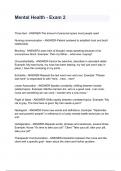Exam (elaborations)
Mental Health - Exam 2
- Course
- Institution
Three feet - ANSWER-The amount of personal space most people need Nursing communication - ANSWER-Patient centered to establish trust and build relationship Blocking - ANSWER-Loses train of thought; stops speaking because of an unconscious block. Example: Then my father... what was I saying? Ci...
[Show more]



